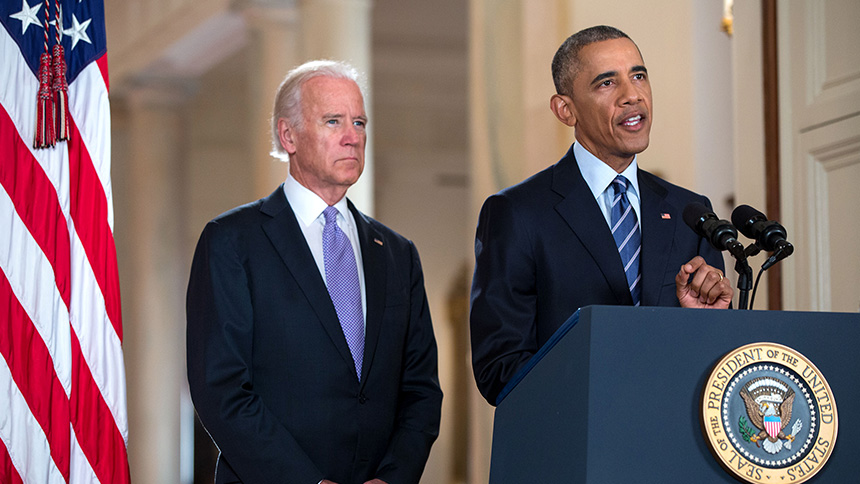Everything You Need to Know: Helping Responsible Homeowners Refinance
In his State of the Union address, President Obama laid out a Blueprint for an America Built to Last, and called for action to help our housing market recover by assisting responsible homeowners who are trapped by high interest rate mortgages and falling home values. While the government cannot fix the housing market on its own, the President believes that responsible homeowners should not have to wait for the market to hit bottom to get relief: There are available measures that can make a meaningful difference, including allowing these homeowners to save thousands of dollars each year by refinancing at today’s low interest rates.
The President has outlined a plan that uses a broad range of tools to support homeowners, including expanding access to refinancing that will help them save hundreds of dollars per month on their mortgage payments --even if they owe more on their mortgage than their home is worth -- establishing new protections against risky or predatory lending practics, putting construction workers back on the job, and helping rebuild communities that were hit hard by the mortgage crisis.
We’ve put together a guide to help you understand some of the details behind the President’s plan for the housing market and explain how it could help millions of homeowners across the country.
- Expanding eligibility for refinancing at today’s low rates
- Helping homeowners rebuild equity
- Helping more homeowners stay in their homes
- Helping our housing market and getting construction workers back to work
- Protecting homeowners with a Homeowner Bill of Rights
- Investigating mortgage misconduct
Expanding eligibility for refinancing at today’s low rates
President Obama has already taken steps to help responsible homeowners with federally backed mortgages—those held by Freddie Mac and Fannie Mae—save money each month by allowing them to refinance their mortgages at today’s historically low interest rates, even if they are underwater. Now he is calling on Congress to pass a plan that would allow millions more to access refinancing and the savings it offers.
First, the plan would establish a new program that enables nearly every homeowner who is current on their mortgage payments to save $3,000 a year on average through refinancing—regardless of what type of lender owns the mortgage or whether or not homeowners owe more on their mortgages than their home is worth. Borrowers will apply for the new program through a streamlined process designed to make it simpler and less expensive to refinance.
Eligibility requirements are very straightforward--any homeowner with a non-federally guaranteed loan who meets the following criteria would qualify for refinancing under this new program:
- No missed mortgage payments in the last six months, and no more than one missed payment in the six months before that
- A current FICO score of at least 580 (approximately nine in ten borrowers meet this requirement)
- The loan being refinanced is not worth more than area median home values, as determined by Federal Housing Administration conforming loan limits
- The loan being refinanced is for a single-family, owner-occupied principal residence (to be sure that the program benefits responsible homeowners trying to stay in their homes)
This cost of this new refinancing program will be fully offset through a fee on the largest financial institutions based on their size and the riskiness of their activities--it won’t add a dime to the deficit.
Second, President Obama’s plan would further expand access to programs that are already in place to help homeowners with federally backed mortgages refinance. Many people are currently unable to take advantage of these programs because of a number of barriers, including complicated applications, restrictive eligibility requirements, the need for expensive appraisals, and a lack of competition among mortgage lenders.
President Obama’s new plan would remove many of those barriers by simplifying application and eligibility requirements, eliminating appraisal costs, enhancing competition among lenders so that borrowers can get the best deal, and allowing all homeowners are current on their Fannie Mae or Freddie Mac loans to refinance, regardless of whether or not they are underwater on their mortgage.
Helping homeowners rebuild equity
The President’s plan to expand opportunities for refinancing will also give homeowners who are underwater on their mortgages the chance to rebuild equity in their homes. Instead of reducing their monthly payments, borrowers who owe more than the current market value of their home will have the option to refinance into a shorter-term, lower interest rate loan, and commit to applying that savings to rebuilding equity more quickly. The total monthly payment after refinancing would be roughly equal to their current mortgage payment, but a portion would pay down the principal mortgage balance, instead of interest.
To give one example, Susan is making monthly payments of $1,350 on her 6.5 percent 30-year mortgage, which has an outstanding balance of $200,000—although her house is now worth $160,000. If Susan simply refinanced into a 4.25 percent 30-year mortgage, she would reduce her monthly payments by $370. But at the end of five years, Susan's mortgage balance would be $182,000—still more than her house is worth.
Under the equity-building opportunity the President is proposing, she could instead choose to refinance into a mortgage that allows her to pay more toward the principal on her loan. After five years of making monthly payments roughly equal to what she was paying before refinancing, she could bring the mortgage balance to $152,000
This option would give the majority of underwater borrowers like Susan the chance to get back above water within five years. To further encourage homeowners to rebuild equity in their homes, borrowers who chose this option would not be responsible for covering the closing costs of refinancing.
Helping more homeowners stay in their homes
Last summer, the Obama Administration announced that it would allow unemployed borrowers in some existing federal loan programs to put their mortgages in forbearance for 12 months. This forbearance period—a time when homeowners can postpone making mortgage payments—allows borrowers to stay in their homes while they look for jobs, which gives these families a better chance of avoiding default and helps the housing market by reducing the number of foreclosures.
Thanks to President Obama’s lead, a 12-month forbearance period is slowly becoming the norm for a majority of mortgage lenders. Frannie Mae and Freddie Mac, which cover half the mortgage market between them, are now providing a full year of relief for homeowners looking for work, as are Wells Fargo and Bank of America.
In addition, to help more homeowners avoid foreclosure, the Administration is expanding its program to help borrowers modify the terms of their mortgages and stay in their homes. So far, the Administration’s initiatives – combined with private-sector efforts – helped over 4.6 million borrowers modify their mortgages. The Administration recently expanded eligibility for these modifications so that it provides support to a broader pool of borrowers, while increasing incentives for modifications that help borrowers reduce principal on their loans.
Helping our housing market and getting construction workers back to work
Neighborhoods full of vacant and foreclosed houses bring down the value of the all the nearby homes, putting further stress on our housing market. President Obama’s plan includes two initiatives to address blighted neighborhoods:
- A pilot program to auction foreclosed, bank-owned homes to investors who will turn them into rental properties, which will help reduce the number of unsold homes, improve area home prices and create affordable housing options for renters.
- A budget proposal to invest $15 billion in putting construction workers—more than a million of whom remain unemployed in the fallout of the housing crisis—back on the job rehabilitating and refurbishing hundreds of thousands of vacant, foreclosed homes and businesses.
Protecting homeowners with a Homeowner Bill of Rights
When the housing bubble burst, millions of families who did the right and responsible thing – shopped for a home, secured a mortgage, and made their payments on time each month – were hurt badly. Homeowners lost trillions of dollars in equity when home values plummeted; leaving the nest egg they spent years investing in worth less than what they paid for it. Millions of others lost their homes altogether through foreclosure, many after depleting their savings trying to keep up with ballooning payments on mortgages lenders shouldn’t have sold them in the first place.
Many of these homeowners were left with nothing because of the irresponsible actions of others in a financial industry that was unregulated and unchecked. And when the house of cards finally broke down, it triggered the worst economic crisis since the Great Depression.
To make sure this sort of risky financial behavior never threatens our nation’s homeowners again, President Obama will work closely with regulators, Congress and other stakeholders to create a robust and comprehensive set of rules that better serves borrowers, investors, and the overall housing market.
These rules will be driven by the following set of core principles:
- Simple, easy to understand mortgage forms
- No hidden fees and penalties
- No conflicts of interest
- Assistance for at-risk homeowners
- Safeguards against inappropriate foreclosure
Investigating mortgage misconduct
To continue investigating the misconduct involved in predatory mortgage lending as well as the selling and packaging of mortgage-backed securities and the role those practices played in the financial crisis, the Department of Justice, the Department of Housing and Urban Development, the Securities and Exchange Commission and state Attorneys General have formed a Residential Mortgage-Backed Securities Working Groupunder President Obama’s Financial Fraud Enforcement Task Force.
This working group will consist of at least 55 DOJ attorneys, analysts, agents and investigators from around the country who will join existing state and federal investigations of similar misconduct. The working group will be co-chaired by senior officials at the Department of Justice and SEC, and New York Attorney General Schneiderman will lead the effort from the state level.
A settlement that will provide homeowners relief and change practices at the largest servicers
Earlier this month, the Federal Government and 49 state attorneys general announced a landmark settlement to address mortgage loan servicing and foreclosure abuses.This agreement – which represents the largest federal-state civil settlement ever agreed to – will require five major servicers to provide over $25 billion in relief to homeowners.
That relief includes at least $10 billion to write down principal for borrowers who owe more on their mortgages than their homes are worth, at least $3 billion to support refinancing for responsible borrowers, and up to $7 billion in support for the unemployed, service members and distressed communities.
In addition, the agreement will require the mortgage servicers to implement unprecedented changes in how they service mortgage loans and handle foreclosures – helping to prevent some of the abuses that led to the crisis. In doing so, it takes a major step towards implementing some of the principles put forward in the Homeowner Bill of Rights.
What’s next?
As President Obama explained when he laid out his proposal, no policy or program will solve all the problems in a multitrillion-dollar housing market. It’s going to take time to recover, but there are steps we can start taking now to help homeowners and our housing market—and even more can be done if Congress acts to pass this plan.



